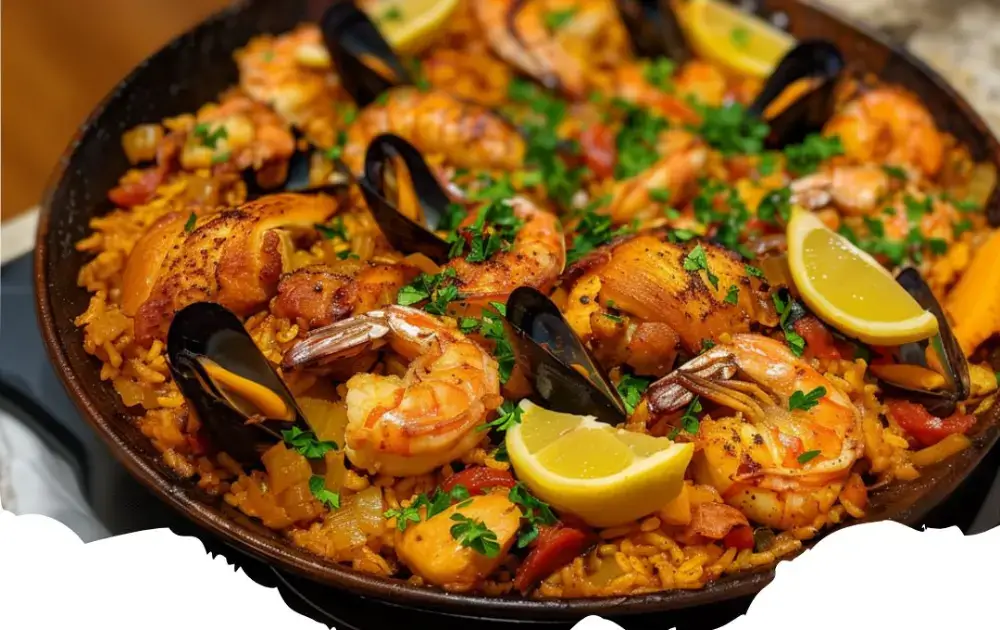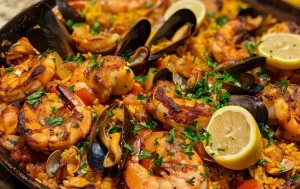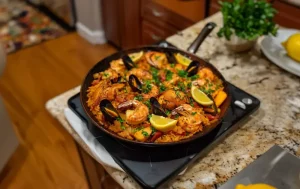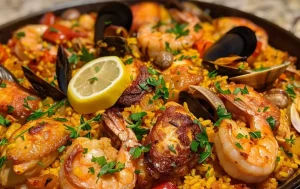Seafood Paella is a colorful and aromatic dish that hails from the Valencia region of Spain, celebrated for its rich blend of seafood, saffron-infused rice, and vibrant vegetables. This dish is not just a meal; it’s a culinary experience that brings people together. Traditionally cooked in a large paellera over an open flame, seafood paella is perfect for gatherings, offering a feast for the senses with its enticing flavors and eye-catching presentation.
Choosing the Right Ingredients
The success of a Seafood Paella lies in the quality of its ingredients. Start with a good base of short-grain rice, such as Bomba or Calasparra, which is excellent at absorbing flavors. Fresh seafood is key—include a mix of shrimp, mussels, clams, and squid for variety and texture. The distinctive flavor of saffron, along with a hearty fish stock, gives the dish its signature taste and color. Fresh vegetables like bell peppers, tomatoes, and peas add freshness and vibrancy to the paella.
Preparing the Seafood
Clean and prepare the seafood carefully before cooking. Devein the shrimp, scrub the mussels and clams, and clean the squid, cutting it into rings. Lightly season the seafood with salt and pepper. In the paella pan, sauté the seafood until it’s just cooked through, then set it aside. This ensures that the seafood remains tender and juicy, preventing it from becoming overcooked during the final stages of making the paella.
Cooking the Paella
In the same pan used for the seafood, sauté diced onions, garlic, and sliced bell peppers until softened. Add the rice, stirring to coat it in the mixture, and toast it slightly. Then, add the saffron-infused fish stock, spreading the rice evenly across the pan. Allow the paella to simmer gently, resisting the urge to stir, as this helps to develop the socarrat—a crispy layer of rice at the bottom of the pan that is highly prized.
Assembling the Dish
Once the rice has absorbed most of the liquid and is nearly cooked, arrange the seafood on top of the paella, along with peas and slices of lemon for garnish. Cover the pan with foil and cook for a few more minutes until the seafood is heated through and the rice is tender. The final dish should be moist but not soupy, with each grain of rice distinct and infused with flavor.
Serving Seafood Paella
Serve Seafood Paella directly from the pan to capture the essence of communal dining. Garnish with fresh parsley and offer lemon wedges on the side for guests to squeeze over their servings, adding a bright burst of flavor. A chilled white wine or sangria complements the dish beautifully, rounding out the meal with Spanish flair. Seafood Paella is not just food; it’s an occasion, bringing joy and warmth to any table.
Mastering the Art of Socarrat
Achieving a perfect socarrat is considered the hallmark of a skilled paella chef. To create this coveted crispy rice layer, monitor the heat carefully in the final stages of cooking. Once you hear a faint crackling sound, reduce the heat to low and let the paella cook undisturbed for a few more minutes. The key is to form the socarrat without burning the rice, which requires a delicate balance of timing and temperature. This crispy bottom adds a delightful texture contrast and depth of flavor to the Seafood Paella.
Enhancing Flavors with Garnishes
Beyond the traditional ingredients, garnishes can play a significant role in enhancing the flavors and presentation of Seafood Paella. A sprinkle of finely chopped parsley adds a fresh, herbal note, while lemon wedges serve not just as a garnish but also allow guests to adjust the acidity to their taste. For an extra kick, offer a side of aioli or a spicy sauce for those who enjoy a bit of heat with their paella.
Tips for Outdoor Paella Cooking
Cooking Seafood Paella outdoors over an open flame can add an authentic touch to the dish, mimicking the traditional Valencian method. If you’re using a charcoal grill or a paella burner, ensure even heat distribution by adjusting the coals or flame. Cooking outdoors also presents an opportunity to turn the meal preparation into a social event, inviting guests to watch and engage in the cooking process, creating a memorable experience.
Pairing with the Perfect Beverage
Choosing the right beverage to accompany Seafood Paella can enhance the overall dining experience. A crisp, dry Spanish white wine like Albariño or Verdejo complements the seafood flavors beautifully. For those who prefer red wine, a young, light-bodied Tempranillo can be a good match. Alternatively, a classic Spanish sangria with its fruity and refreshing notes offers a festive pairing for this vibrant dish.
Sharing the Tradition of Paella
Introducing friends and family to Seafood Paella is not just about sharing a meal but also about sharing a piece of Spanish culture and culinary tradition. Discussing the history of the dish, the importance of socarrat, and the communal aspect of paella dining can enrich the experience. Encouraging everyone to gather around the pan and serve themselves reinforces the communal spirit that is central to the enjoyment of paella, making the meal a truly communal and festive occasion.
Adapting the Recipe for Different Tastes
Seafood Paella is wonderfully adaptable to different tastes and dietary preferences. For a heartier version, consider adding chicken or rabbit, traditional in many Valencian paellas. Vegetarian guests can enjoy a vegetable paella, rich with artichokes, beans, and peppers. Each variation retains the essence of paella while catering to the diverse palates of your diners. Exploring these adaptations allows you to celebrate the versatility of this beloved dish.
Emphasizing Sustainable Seafood Choices
In creating Seafood Paella, the choice of seafood can impact both the dish’s flavor and the environment. Opting for sustainably sourced seafood ensures the long-term health of marine ecosystems. Look for certifications or ask your seafood supplier about the origin of their products. This commitment not only contributes to the preservation of ocean life but also ensures the highest quality and freshness for your paella.
Creating an Interactive Cooking Experience
Turning the preparation of Seafood Paella into an interactive cooking experience can add excitement and engagement to any gathering. Invite guests to participate in adding ingredients to the pan or to take turns watching the dish as it cooks. This interactive approach transforms meal preparation from a solitary task into a shared activity, fostering a sense of community and collaboration among your guests.
Exploring Regional Paella Variations
While Seafood Paella is widely beloved, exploring other regional paella variations introduces diners to the rich tapestry of Spanish cuisine. From the rabbit and snail paella of the Valencian region to the mixed paella that includes a variety of meats and seafood, each variant offers unique flavors and ingredients. Experimenting with these regional specialties provides a culinary tour of Spain, celebrating the diverse cultures and traditions that contribute to the country’s rich gastronomic heritage.
Reflecting on Paella’s Place in Culinary Tradition
Seafood Paella is more than a dish; it’s a reflection of Spain’s culinary tradition, representing the fusion of cultures, ingredients, and cooking methods that have shaped Spanish cuisine over centuries. Sharing this dish is an opportunity to delve into the history and stories behind paella, from its humble origins to its status as a symbol of Spanish identity and pride. Engaging with this culinary tradition enriches the dining experience, inviting a deeper appreciation for the art and culture of paella making.
Exploring Regional Variations
Seafood Paella might hail from Valencia, but regions across Spain offer their unique takes on this beloved dish. Exploring these variations can be a culinary adventure, from the meat-heavy versions in the interior to the vegetable-centric ones along the coast. Incorporating local and seasonal ingredients reflects the region’s culinary heritage and provides a deeper understanding of Spain’s diverse food culture. Whether it’s adding rabbit and snails in a traditional Valencian paella or embracing the all-seafood creations found along the Spanish coast, each variation tells a story of its origins.
Utilizing Sustainable Seafood
In creating Seafood Paella, prioritizing sustainable seafood choices is crucial for both the environment and the dish’s quality. Opting for seafood that’s been responsibly sourced or certified by environmental organizations helps protect ocean life and habitats. This commitment not only contributes to the conservation efforts but also ensures the seafood in your paella is of the highest freshness and quality, enhancing the overall taste of the dish.
Navigating the Challenges of Large-Scale Cooking
Preparing Seafood Paella for a large group presents its own set of challenges, from ensuring even cooking across a large paellera to managing the timing of adding each ingredient. To navigate these challenges, practice and preparation are key. Segmenting ingredients, having a clear cooking timeline, and using a reliable heat source can turn the daunting task of cooking for many into a manageable and enjoyable experience. Engaging guests in the cooking process can also transform meal preparation into an interactive party highlight.
The Importance of Resting Time
Allowing the Seafood Paella to rest after cooking is an often-overlooked step that can make a significant difference in the dish’s final texture and flavor. Covering the paella pan with a clean cloth or foil for several minutes before serving helps the rice absorb any remaining moisture and ensures that the heat is evenly distributed throughout the dish. This brief resting period allows the flavors to meld together harmoniously, ensuring that your Seafood Paella is moist, flavorful, and ready to delight your guests.
Celebrating Through Paella
More than just a meal, Seafood Paella is a celebration of culture, friendship, and the joy of eating together. Its preparation and presentation can turn any gathering into a festive occasion, filled with laughter, shared stories, and communal enjoyment of a delicious, heartwarming dish. Inviting friends and family to partake in both the cooking and the eating of Seafood Paella reinforces the bonds between loved ones, making the meal a memorable event that goes beyond the food itself to celebrate the warmth of togetherness.
FAQs about Seafood Paella
Q1: Can I make Seafood Paella without a paella pan? A1: Yes, you can use a wide, shallow skillet as an alternative. The key is to ensure the pan is broad enough to spread the rice thinly and allow for even cooking.
Q2: How do I prevent my paella rice from getting mushy? A2: Use the correct rice-to-liquid ratio, typically 1 part rice to 2 parts liquid. Also, avoid stirring the rice once you’ve added the liquid to prevent releasing too much starch.
Q3: What can I use instead of saffron for the color? A3: While saffron is traditional for its flavor and color, turmeric can be used as a substitute to achieve the golden hue typical of paella, albeit with a different flavor profile.
Q4: Is it necessary to use fish stock, or can I use vegetable or chicken stock? A4: Fish stock is preferred for its depth of flavor, but vegetable or chicken stock can be used as alternatives. The key is to ensure the stock is flavorful as it forms the base of your paella.
Q5: Can Seafood Paella be made in advance? A5: It’s best served fresh, but you can prepare your ingredients and stock in advance. Cook the paella just before serving to enjoy its best texture and taste.
Conclusion
Seafood Paella is not just a dish; it’s a culinary journey that celebrates the rich tapestry of Spanish cuisine. Through the careful selection of ingredients, attention to cooking techniques, and the joy of sharing with others, Seafood Paella stands as a testament to the power of food to bring people together. Whether it’s the delicate flavor of the seafood, the aroma of saffron, or the communal experience of cooking and eating, Seafood Paella offers a unique and unforgettable dining experience. Embracing the traditions and variations of this dish allows both novice cooks and seasoned chefs to explore the flavors of Spain, making every paella a celebration of culture, friendship, and the simple pleasures of eating well.
Print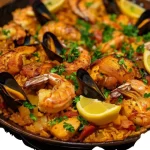
Seafood Paella
- Author: recipstep
- Total Time: 1 hour
- Yield: 6 servings
Description
Seafood Paella is a vibrant Spanish dish known for its rich combination of saffron-infused rice and a variety of fresh seafood. This culinary masterpiece, originating from Valencia, is celebrated for its flavors and communal dining experience. Perfect for any occasion, Seafood Paella brings a taste of the Mediterranean to your table.
Ingredients
2 cups rice
1 lb chicken thighs, bone-in, skin-on
1/2 lb large shrimp, peeled and deveined
1/2 lb mussels, cleaned and debearded
1/2 lb clams, scrubbed and cleaned
1 onion, finely chopped
4 cloves garlic, minced
1 red bell pepper, diced
1 tomato, grated
1/2 cup green beans, chopped into 1-inch pieces
1 teaspoon saffron threads, soaked in warm water
1 teaspoon smoked paprika
1 lemon, cut into wedges
4 cups chicken broth
1/4 cup flat-leaf parsley, chopped
Olive oil for cooking
Salt and pepper to taste
Instructions
Prepare the Ingredients: Season chicken with salt, pepper, and smoked paprika. Soak saffron threads in warm water. Clean and devein shrimp, scrub mussels, and clean clams.
Heat the Pan: In a large paella pan or wide skillet, heat olive oil over medium-high heat.
Sear Chicken: Brown chicken pieces until golden on all sides. Remove and set aside.
Sauté Aromatics: In the same pan, sauté onions, garlic, and red bell pepper until softened.
Stir in rice, cooking for 2-3 minutes until rice is well-coated and slightly toasted.
Pour in Chicken Broth: Pour in chicken broth, grated tomato, saffron with water, and smoked paprika. Stir to combine. Nestle the seared chicken back into the rice mixture. Arrange shrimp, mussels, clams, and green beans evenly.
Simmer and Cook: Reduce heat to medium-low and let the paella simmer for about 20-25 minutes or until rice is cooked, and the liquid is absorbed.
Once cooked, remove from heat, cover with a kitchen towel, and let it rest for 5 minutes. This allows the flavors to meld.
Serve
Pro Tips:
Use a paella pan for even cooking and the traditional presentation.
Add the seafood towards the end to prevent overcooking.
Use high-quality saffron for authentic flavor.
Enjoy your delightful Seafood Paella!
Notes
- For an authentic flavor, aim for a thin layer of rice in the pan to achieve the perfect socarrat.
- The seafood can be varied according to preference or availability.
- Bomba rice absorbs more liquid than regular rice; adjust the stock accordingly if substituting.
- Prep Time: 20 minutes
- Cook Time: 40 minutes
- Category: Main Dish
- Method: Stovetop
- Cuisine: Spanish
Nutrition
- Calories: 450
- Sugar: 5g
- Sodium: 700mg
- Fat: 10g
- Saturated Fat: 2g
- Carbohydrates: 65g
- Fiber: 3g
- Protein: 25g
- Cholesterol: 120mg

